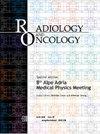The superior value of radiomics to sonographic assessment for ultrasound-based evaluation of extrathyroidal extension in papillary thyroid carcinoma: a retrospective study.
IF 2.1
4区 医学
Q3 ONCOLOGY
引用次数: 0
Abstract
BACKGROUND Extrathyroidal extension was related with worse survival for patients with papillary thyroid carcinoma. For its preoperative evaluation, we measured and compared the predicting value of sonographic method and ultrasonic radiomics method in nodules of papillary thyroid carcinoma. PATIENTS AND METHODS Data from 337 nodules were included and divided into training group and validation group. For ultrasonic radiomics method, a best model was constructed based on clinical characteristics and ultrasonic radiomic features. The predicting value was calculated then. For sonographic method, the results were calculated using all samples. RESULTS For ultrasonic radiomics method, we constructed 9 models and selected the extreme gradient boosting model for its highest accuracy (0.77) and area under curve (0.813) in validation group. The accuracy and area under curve of sonographic method was 0.70 and 0.569. Meanwhile. We found that the top-6 important features of xgboost model included no clinical characteristics, all of whom were high-dimensional radiomic features. CONCLUSIONS The study showed the superior value of ultrasonic radiomics method to sonographic method for preoperative detection of extrathyroidal extension in papillary thyroid carcinoma. Furthermore, high-dimensional radiomic features were more important than clinical characteristics.基于超声评估甲状腺乳头状癌甲状腺外扩展的放射组学优于超声评估的价值:一项回顾性研究。
背景甲状腺外扩展与甲状腺乳头状癌患者的生存率降低有关。为了对其进行术前评估,我们测量并比较了声像图法和超声放射组学法对甲状腺乳头状癌结节的预测价值。对于超声放射学方法,根据临床特征和超声放射学特征构建最佳模型。然后计算预测值。结果对于超声放射组学方法,我们构建了 9 个模型,并在验证组中选择了准确率(0.77)和曲线下面积(0.813)最高的极梯度增强模型。超声波放射组学方法的准确率和曲线下面积分别为 0.70 和 0.569。同时。结论该研究表明,超声放射组学方法在甲状腺乳头状癌术前检测甲状腺外扩展的价值优于声像图方法。此外,高维放射学特征比临床特征更重要。
本文章由计算机程序翻译,如有差异,请以英文原文为准。
求助全文
约1分钟内获得全文
求助全文
来源期刊

Radiology and Oncology
ONCOLOGY-RADIOLOGY, NUCLEAR MEDICINE & MEDICAL IMAGING
CiteScore
4.40
自引率
0.00%
发文量
42
审稿时长
>12 weeks
期刊介绍:
Radiology and Oncology is a multidisciplinary journal devoted to the publishing original and high quality scientific papers and review articles, pertinent to diagnostic and interventional radiology, computerized tomography, magnetic resonance, ultrasound, nuclear medicine, radiotherapy, clinical and experimental oncology, radiobiology, medical physics and radiation protection. Therefore, the scope of the journal is to cover beside radiology the diagnostic and therapeutic aspects in oncology, which distinguishes it from other journals in the field.
 求助内容:
求助内容: 应助结果提醒方式:
应助结果提醒方式:


